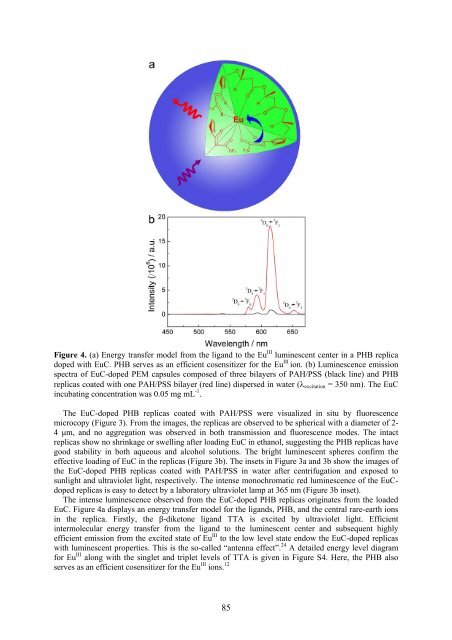Workshop proceeding - final.pdf - Faculty of Information and ...
Workshop proceeding - final.pdf - Faculty of Information and ...
Workshop proceeding - final.pdf - Faculty of Information and ...
Create successful ePaper yourself
Turn your PDF publications into a flip-book with our unique Google optimized e-Paper software.
Figure 4. (a) Energy transfer model from the lig<strong>and</strong> to the Eu III luminescent center in a PHB replica<br />
doped with EuC. PHB serves as an efficient cosensitizer for the Eu III ion. (b) Luminescence emission<br />
spectra <strong>of</strong> EuC-doped PEM capsules composed <strong>of</strong> three bilayers <strong>of</strong> PAH/PSS (black line) <strong>and</strong> PHB<br />
replicas coated with one PAH/PSS bilayer (red line) dispersed in water (λ excitation = 350 nm). The EuC<br />
incubating concentration was 0.05 mg mL -1 .<br />
The EuC-doped PHB replicas coated with PAH/PSS were visualized in situ by fluorescence<br />
microcopy (Figure 3). From the images, the replicas are observed to be spherical with a diameter <strong>of</strong> 2-<br />
4 μm, <strong>and</strong> no aggregation was observed in both transmission <strong>and</strong> fluorescence modes. The intact<br />
replicas show no shrinkage or swelling after loading EuC in ethanol, suggesting the PHB replicas have<br />
good stability in both aqueous <strong>and</strong> alcohol solutions. The bright luminescent spheres confirm the<br />
effective loading <strong>of</strong> EuC in the replicas (Figure 3b). The insets in Figure 3a <strong>and</strong> 3b show the images <strong>of</strong><br />
the EuC-doped PHB replicas coated with PAH/PSS in water after centrifugation <strong>and</strong> exposed to<br />
sunlight <strong>and</strong> ultraviolet light, respectively. The intense monochromatic red luminescence <strong>of</strong> the EuCdoped<br />
replicas is easy to detect by a laboratory ultraviolet lamp at 365 nm (Figure 3b inset).<br />
The intense luminescence observed from the EuC-doped PHB replicas originates from the loaded<br />
EuC. Figure 4a displays an energy transfer model for the lig<strong>and</strong>s, PHB, <strong>and</strong> the central rare-earth ions<br />
in the replica. Firstly, the β-diketone lig<strong>and</strong> TTA is excited by ultraviolet light. Efficient<br />
intermolecular energy transfer from the lig<strong>and</strong> to the luminescent center <strong>and</strong> subsequent highly<br />
efficient emission from the excited state <strong>of</strong> Eu III to the low level state endow the EuC-doped replicas<br />
with luminescent properties. This is the so-called “antenna effect”. 24 A detailed energy level diagram<br />
for Eu III along with the singlet <strong>and</strong> triplet levels <strong>of</strong> TTA is given in Figure S4. Here, the PHB also<br />
serves as an efficient cosensitizer for the Eu III ions. 12<br />
85
















